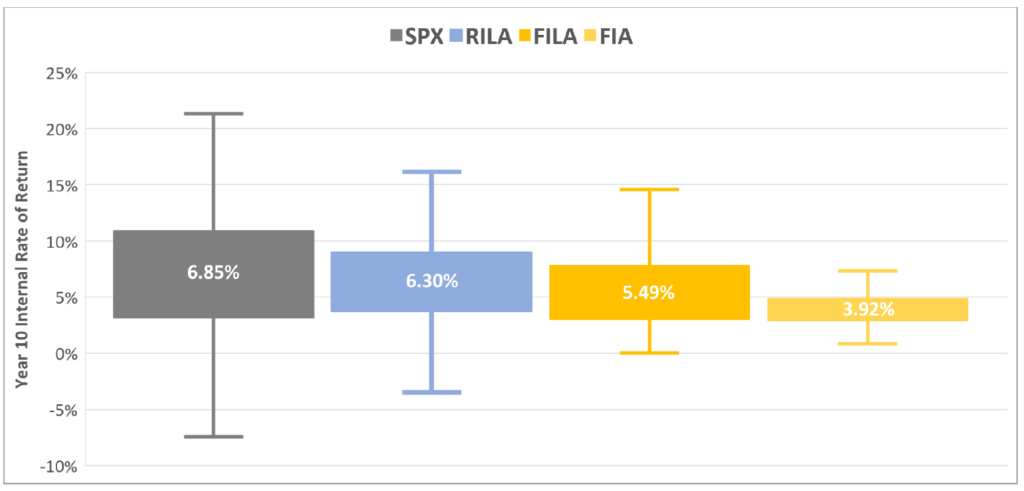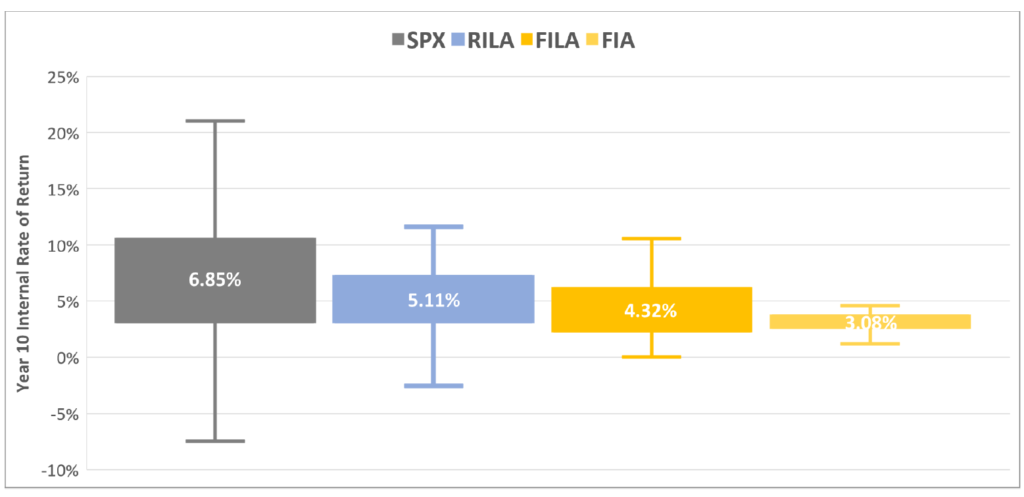Updated May 19, 2022, at 3:33 PM
What are the performance characteristics of the fixed index-linked annuity, or FILA? Before we get into the product’s appeals, let’s take a step back to get a wider angle.
The risk and return spectrum of index-linked annuities vary. The easiest way to visualize where different annuity products slot into the market is by using a spectrum of risk and return.
On one end is a classic declared rate fixed deferred annuity (FDA), and on the other end is a variable annuity (VA), with index-linked products falling in between.
Conceptually, organizing products this way makes a lot of sense and that’s how the products are often positioned with clients. The spectrum might look something like this:

Where Fixed Index-Linked Annuities (FILAs) Fit
On the spectrum above, FILAs could stretch all the way from the beginning of the FIA and to the RILA section, depending on the client’s performance and choices.
But for the purposes of this discussion, we assume that the client elects to put gains at risk throughout the term even though, in reality, they can (and potentially would) choose to take their gains off of the table by selecting a 0% floor account that would mirror the performance of an FIA going forward.
Real-World Simulation of Risk and Return: Participation Rate
To get a feel for how these products might perform using realistic market return simulations, we ran 1,000 S&P 500-based 10-year scenarios through each product chassis using fair-market participation rates.
The chart below shows the results of the simulation. The number in the box is the average annualized return. The box represents the middle 50% of returns with the top and bottom quartiles represented by the whiskers.
For FILAs, the 0% floor rates match the rates in an FIA. The rates for the -10% floor match the rates for RILAs, which we assume is also allocated to a -10% floor account.

Related: The Emergence of the Fixed Index-Linked Annuity (FILA)
In general, our findings are exactly what we’d expect to see: taking more risk leads to greater returns.
- The S&P 500 (without dividends, SPX) produces the highest annualized return but also has the greatest risk, with some ten-year periods producing returns less than -5% but as high as 22%
- The RILA chassis has less risk than the SPX but also a lower mean return, while still potentially producing scenarios with negative ten-year annualized returns of nearly -5% and topping out at 16%
- The FIA chassis virtually guarantees some interest over the period because it locks in all gains, but its average return is relatively low and the upside potential is limited
- The FILA falls directly between FIAs and RILAs, limiting downside risk to 0% over ten years while providing a much higher average return than FIA and nearly as much maximum upside as RILA
Real-World Simulation of Risk and Return: Cap
We re-ran the scenario but this time using caps as the non-guaranteed element and assumed a 100% participation rate. The results are below and shown in the same way as the previous graph.

As expected, cap designs generate lower average returns and less maximum upside potential than participation rates. However, the relative comparisons between the products hold.
In terms of average return, RILAs outperform FILAs by 0.81% using a participation rate and 0.79% using a cap as the non-guaranteed element. FILAs, in turn, outperform FIAs by 1.57% using a participation rate and 1.24% using a cap.
Bottom Line on FILAs
Based on our analysis, FILAs represent a clear middle ground between the traditional FIA and the RILA, offering the principal protection of FIAs with the opportunity to generate RILA-like upside potential by putting gains at risk.
Keep Reading: A Deep Dive into FILA Mechanics
Editor’s Note: This article is from our partners at LifeInnovators.com, and the PDF version can be downloaded for free here.
To learn more about FILAs and other independent life insurance
and annuity product developments, click the Life Innovators logo below.
Copyright Life Innovators LLC 2022


